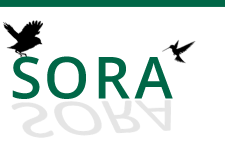Abstract
A fin de conocer la avifauna asociada a un arrozal se realizaron muestreos aplicando el método de transectas lineales. Simultáneamente, se estudio la avifauna de un bosque deciduo aledaño para establecer relaciones entre ambos ambientes y conocer la avifauna de la región en general. En el arrozal se encontraron 48 especies, mostrando una riqueza moderada y un índice de diversidad alto, 34 de las cuales se reportan por primera vez para este cultivo en Venezuela. Por su parte, el bosque registró 90 especies con una riqueza y diversidad altas, reuniendo el área de estudio un total de 104 especies. Sólo 12 de las aves registradas en el arrozal y 28 del bosque resultaron habituales, pero en ambos casos Bubulcus ibis fue la especie más abundante. Más de la mitad (51%) de las aves del arrozal fueron acuáticas, muchas de las cuales también estuvieron en el bosque pues lo utilizaron como dormidero y lugar de anidación. No hubo registros de aves de importancia patrimonial (endémicas, amenazadas) en el arrozal, pero cinco fueron migratorias. Distinto a ello, el bosque albergó tres aves patrimoniales con similar número de migratorias (4). Inesperadamente, hubo un mayor número de aves propias de áreas alteradas en el bosque (27) que en el arrozal (14), un fenómeno relacionado al reemplazo total del ecosistema boscoso original por otro de tipo humedal, atrayendo el último sus propias especies. Aunque en el arrozal se registraron tres aves plagas de alto impacto para el cultivo, estas no fueron observadas en el bosque. En el arrozal las aves se agruparon en 20 familias donde Ardeidae dominó en riqueza y abundancia. Hubo un mayor número de familias (33) en el bosque pues albergó parte de las aves acuáticas del arrozal. Las familias indicadoras de la calidad ambiental estuvieron ausentes en el arrozal, mientras que en el bosque hubo registros de Cracidae, Picidae, Furnariidae, Thamnophilidae y Troglodytidae. Seis gremios alimentarios se encontraron en el arrozal e inesperadamente, carnívoros e insectívoros dominaron sobre los granívoros dada la oferta estacional de granos en el cultivo. En el bosque, un mayor número de gremios (10) estuvo asociado a la oferta de flores y frutos ausentes en el arrozal. Nuestro estudio revela la importancia del arrozal para las aves, principalmente acuáticas y migratorias, así como su vinculación directa con el bosque aledaño dada la importancia del último como refugio, dormidero y lugar de anidación para muchas aves del cultivo.
In order to know the birds associated to a ricefield, bird samples were made using a linear transects technique. Simultaneously, birds of a nearby deciduous forest also were studied in order to establish possible relationships between both environments and to know the overall avifauna in the region. A total of 48 species were found in the ricefield, showing a moderate richness and a high diversity, from which 34 species are reported for the first time to the crop in Venezuela. Also, 90 species were recorded in the forest, showing a high richness and diversity, gathering a total of 104 species to the study area. Just 12 species recorded in the ricefield and 28 of the forest were common, but in both environments Bubulcus ibis dominated the abundance. More than a half (51%) of the ricefield birds corresponded to waterbirds and a significant number of them also were in the forest, since they used it as a roosting and nesting place. There were no records of patrimonial birds (endemic, threatened) in the ricefield but five of them were migrants. Unlike, the forests gathered three endemic birds and a similar number of migrants (4). Unexpectedly, a higher number of disturbed area birds were recorded in the forest (27) compared with those obtained in the ricefield (14), a fact related to the total replacement of the original forest ecosystem by a complete different “wetland type” environment, dragging the ricefield its own species. While ricefield housed three high-impact pest birds, these were not present in the forest. Also, ricefield birds were grouped in 20 families where Ardeidae dominated both in richness and abundance. A higher number of families (33) were found in the forest, an aspect due to the additional forest paper as hosted to waterbirds. Families indicator of environmental quality were absent in the ricefield, while Cracidae, Picidae, Furnariidae, Thamnophilidae, and Troglodytidae were recorded into the forest. Six feeding guilds were found in the ricefield where unexpectedly, carnivores and insectivores dominated on granivores due to a seasonal supply of grains in the crop. In the forest, the higher numbers of guilds (10) were associated with the presence of flowers and fruits absent in the ricefield. Our study reveals the ricefield importance to water and migratory birds, as well as it close relationship with the nearby forest, mostly as refuge for roosting and nesting place to ricefield birds.
Creative Commons License
Recommended Citation
Rico, Adriana; Solórzano, Alecio; and Verea, Carlos
(2011)
"Avifauna asociada a un cultivo de arroz de los llanocentrales de Venezuela / Avifauna Associated to a Ricefi eld in Central Savannas of Venezuela,"
Revista Venezolana de Ornitología: Vol. 1
:
Iss.
1
, Article 2.
Available at:
https://digitalcommons.usf.edu/rvo/vol1/iss1/2

